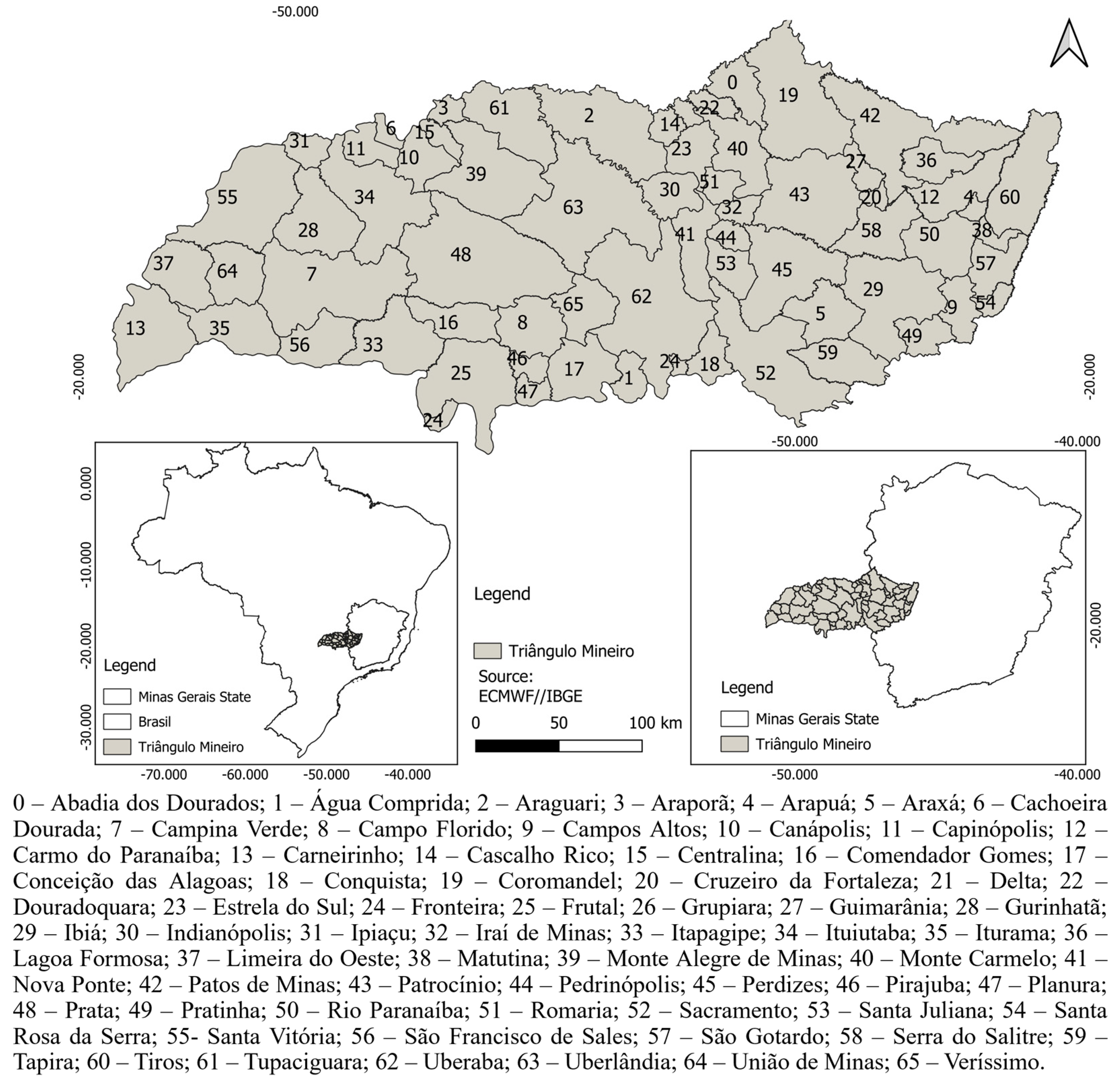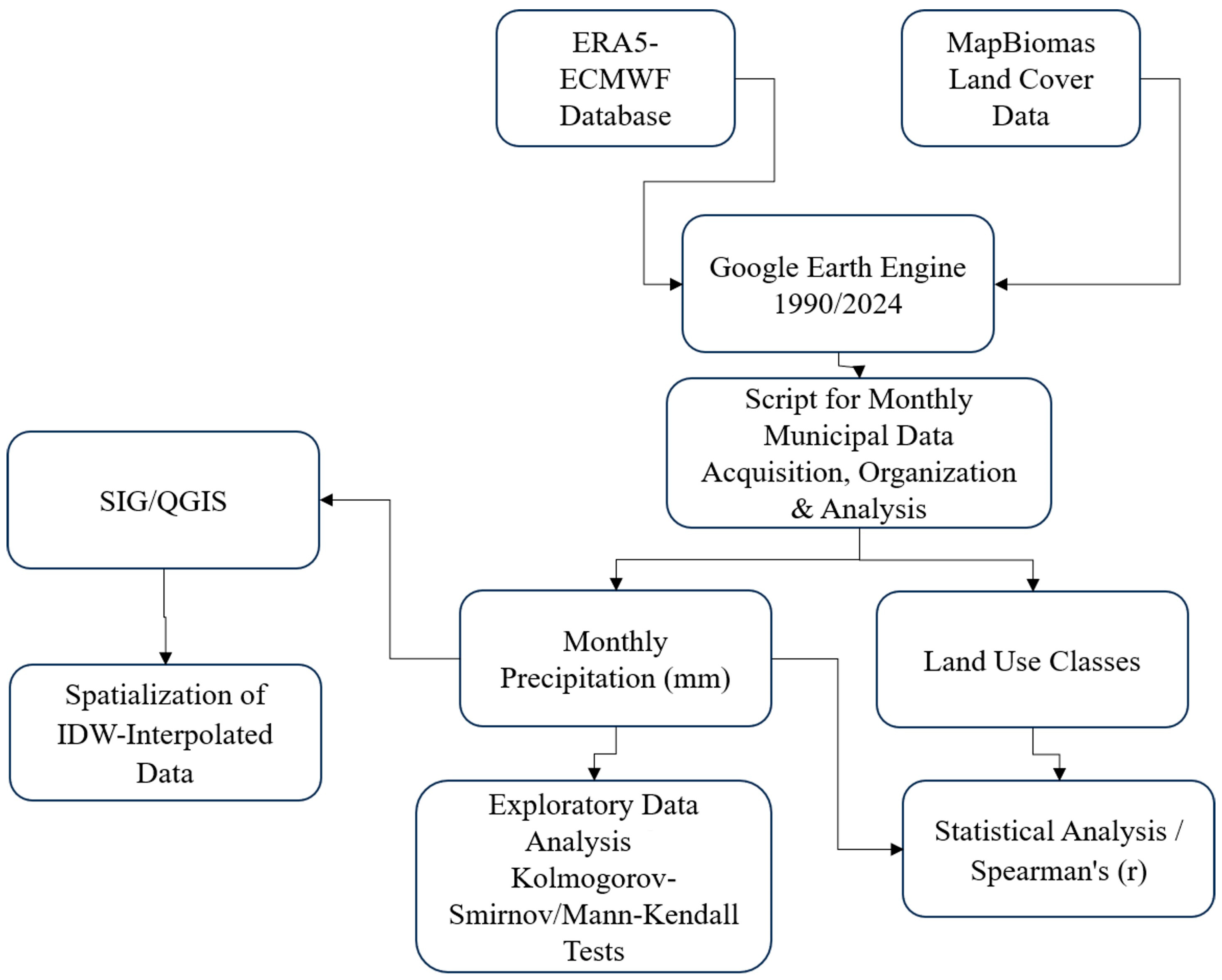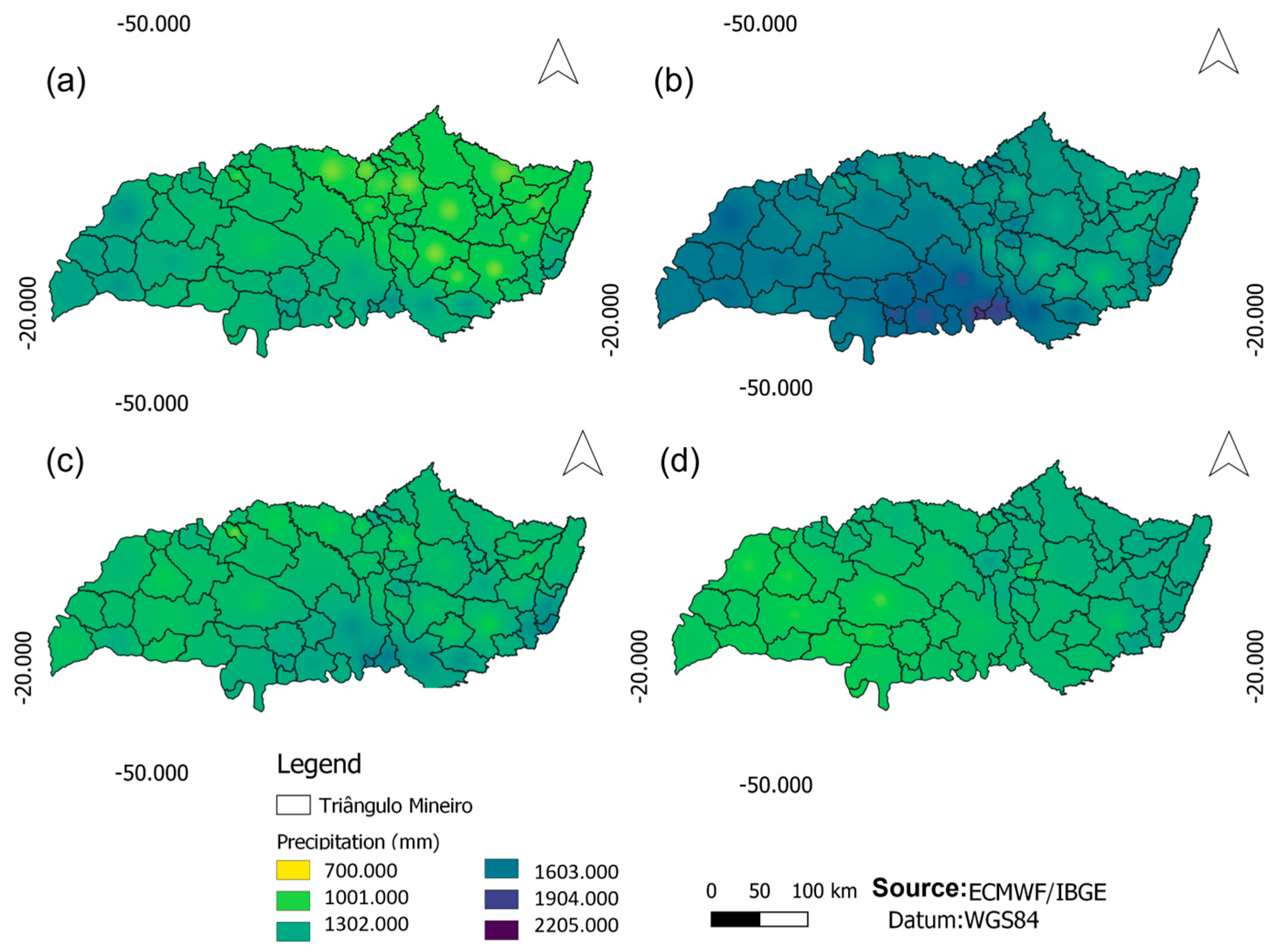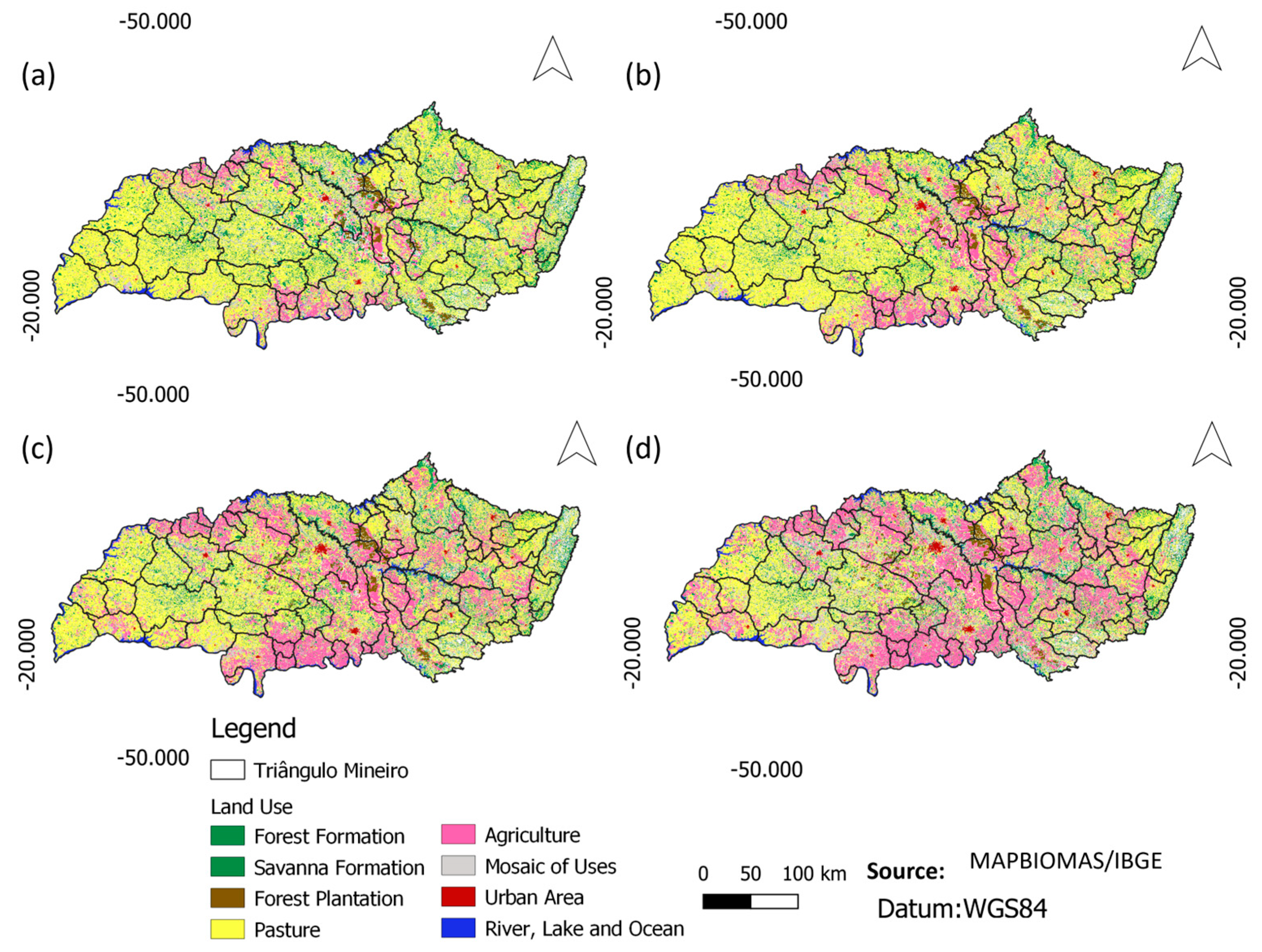Remote Observation of the Impacts of Land Use on Rainfall Variability in the Triângulo Mineiro (Brazilian Cerrado Region)
Abstract
1. Introduction
2. Materials and Methods
2.1. Study Area
2.2. Data Collection and Processing
2.3. Exploratory Data Analysis
| Significance | Symbol | Z |
|---|---|---|
| No Trend | NT | 0 |
| Significant Increasing Trend | SIT | >+1.96 |
| Significant Decreasing Trend | SDT | <−1.96 |
| Non-Significant Increasing Trend | NSIT | <+1.96 |
| Non-Significant Decreasing Trend | NSDT | >−1.96 |
3. Results
4. Discussion
5. Conclusions
Author Contributions
Funding
Data Availability Statement
Conflicts of Interest
References
- IPCC. Climate Change 2014: Synthesis Report. Contribution of Working Groups I, II and III to the Fifth Assessment Report of the Intergovernmental Panel on Climate Change, 1st ed.; Pachauri, R.K., Meyer, L.A., Eds.; IPCC: Geneva, Switzerland, 2014; pp. 1–151. [Google Scholar]
- De Marco, P., Jr.; Villén, S.; Mendes, P.; Nóbrega, C.; Cortes, L.; Castro, T.; Souza, R. Vulnerability of Cerrado Threatened Mammals: An Integrative Landscape and Climate Modeling Approach. Biodivers. Conserv. 2020, 29, 1637–1658. [Google Scholar] [CrossRef]
- FAO—Food and Agriculture Organization of the United Nations. Livestock and Environment. Available online: http://www.fao.org/livestock-environment/en/ (accessed on 15 November 2023).
- Perugini, L.; Caporaso, L.; Marconi, S.; Cescatti, A.; Quesada, B.; De Noblet-Ducoudré, N.; House, J.I.; Arneth, A. Biophysical Effects on Temperature and Precipitation Due to Land Cover Change. Environ. Res. Lett. 2017, 12, 053002. [Google Scholar] [CrossRef]
- Campos, J.D.O.; Chaves, H.M.L. Tendências e Variabilidades nas Séries Históricas de Precipitação Mensal e Anual no Bioma Cerrado no Período 1977–2010. Rev. Bras. Meteorol. 2020, 35, 157–169. [Google Scholar] [CrossRef]
- Urban, M.C.; Bocedi, G.; Hendry, A.P.; Mihoub, J.B.; Pe’er, G.; Singer, A.; Bridle, J.R.; Grozier, L.G.; Meester, L.; Godsoe, W.; et al. Improving the Forecast for Biodiversity under Climate Change. Science 2016, 353, aad8466. [Google Scholar] [CrossRef] [PubMed]
- Arantes, A.E.; Ferreira, L.G.; Coe, M.T. The Seasonal Carbon and Water Balances of the Cerrado Environment of Brazil: Past, Present, and Future Influences of Land Cover and Land Use. ISPRS J. Photogramm. Remote Sens. 2016, 117, 66–78. [Google Scholar] [CrossRef]
- Salmona, Y.B.; Matricardi, E.A.T.; Skole, D.L.; Silva, J.F.A.; Coelho Filho, O.A.; Pedlowski, M.A.; Sampaio, J.M.; Ramírez, L.C.C.; Brandão, R.A.; Silva, A.L.; et al. A worrying future for river flows in the Brazilian Cerrado provoked by land use and climate changes. Sustainability 2023, 15, 4251. [Google Scholar] [CrossRef]
- Silva, C.O.F.; Manzione, R.L.; Caldas, M.M. Net water flux and land use shifts across the Brazilian Cerrado between 2000 and 2019. Reg. Environ. Change 2023, 23, 151. [Google Scholar] [CrossRef]
- Fushimi, M.; de Lima, G.N.; Capoane, V. Changes in land use and cover and their environmental impacts in the Cerrado of Mato Grosso do Sul, Brazil. Sustainability 2024, 16, 4266. [Google Scholar] [CrossRef]
- Moraes, R.A.; Rocha, J.V.; Lamparelli, R.A.C. Determination of Total Accumulated Rainfall, Global Radiation, Evapotranspiration and Degree-Days Originated from the ECMWF Model to Sugar Cane Crop. Eng. Agríc. 2014, 34, 322–331. [Google Scholar] [CrossRef]
- Mahdianpari, M.; Tamiminia, H.; Saleshi, B.; Quackenbush, L.; Adeli, S.; Brisco, B. Google Earth Engine for Geo-Big Data Applications: A Meta-Analysis and Systematic Review. ISPRS J. Photogramm. Remote Sens. 2020, 164, 152–170. [Google Scholar]
- Kumar, L.; Mutanga, O. Google Earth Engine Applications Since Inception: Usage, Trends, and Potential. Remote Sens. 2018, 10, 1509. [Google Scholar] [CrossRef]
- Gorelick, N.; Hancher, M.; Dixon, M.; Ilyushchenko, S.; Thau, D.; Moore, R. Google Earth Engine: Planetary-Scale Geospatial Analysis for Everyone. Remote Sens. Environ. 2017, 202, 18–27. [Google Scholar] [CrossRef]
- Sharnagat, N.; Nema, A.K.; Mishra, P.K.; Patidar, N.; Kumar, R.; Suryawanshi, A.; Radha, L. State-of-the-art status of Google Earth Engine (GEE) application in land and water resource management: A scientometric analysis. J. Geovis. Spat. Anal. 2025, 9, 16. [Google Scholar] [CrossRef]
- Wilson, D.D.; Tefera, G.W.; Ray, R.L. Application of Google Earth Engine to monitor greenhouse gases: A review. Data 2025, 10, 8. [Google Scholar] [CrossRef]
- Ferreira Filho, D.F.; Bezerra, P.E.S.; Silva, M.N.A.; Rodrigues, R.S.S.; Figueiredo, N.M. Aplicação de Técnicas de Interpolação para Espacialização de Chuvas da Rede Hidrográfica: Estudo de Caso Calha Norte–PA. Rev. Bras. Climatol. 2019, 24. [Google Scholar] [CrossRef]
- Instituto Brasileiro de Geografia e Estatística (IBGE). Malhas Territoriais. Available online: https://www.ibge.gov.br/geociencias/organizacao-do-territorio/malhas-territoriais/15774-malhas.html?edicao=43129&t=downloads (accessed on 28 May 2023).
- Cleps, G.D.G.; De Amorim, P.H.S. A Economia Solidária e sua Expansão na Mesorregião do Triângulo Mineiro e Alto Paranaíba–MG. Caminhos Geogr. 2018, 19, 349–360. [Google Scholar] [CrossRef]
- Lopes, R.P.M.; Quaresma, M.P. Desempenho Fiscal dos Municípios: Uma Análise Comparativa para as Mesorregiões do Norte de Minas e Triângulo Mineiro. Rev. Binac. Bras. Argent. Diálogo Cienc. 2023, 12, 293–319. [Google Scholar]
- Fundação João Pinheiro (FJP). Produto Interno Bruto dos Municípios de Minas Gerais, 1st ed.; Diretoria de Estatística e Informações: Belo Horizonte, Brazil, 2022. [Google Scholar]
- Moraes, R.F. Análise das Mudanças do Uso e da Cobertura da Terra em Municípios com Áreas de Mineração na Microrregião de Itabira a partir de Dados do MAPBIOMAS entre 1987 e 2017. Rev. Eng. Interes. Soc. 2020, 5, 77–96. [Google Scholar] [CrossRef]
- MapBiomas. Projeto MapBiomas—Coleção 3.1 da Série Anual de Mapas de Cobertura e Uso de Solo do Brasil. Available online: http://mapbiomas.org/pages/database/mapbiomas_collection (accessed on 15 June 2023).
- Stackhouse, P.W.; MacPherson, B.; Broddle, M.; McNeil, C.; Barnett, A.J.; Mikovitz, C.; Zhang, T. Introduction to the Prediction of Worldwide Energy Resources (POWER) Project. In Proceedings of the NASA Applied Sciences Week 2021, Online, 2–3 October 2021. [Google Scholar]
- Ahmad, I.; Tang, D.; Wang, T.F.; Wang, M.; Wagan, B. Precipitation trends over time using Mann-Kendall and Spearman’s rho tests in Swat River Basin, Pakistan. Adv. Meteorol. 2015, 2015, 431860. [Google Scholar] [CrossRef]
- Triola, M.F. Introdução à Estatística, 12th ed.; LTC: Rio de Janeiro, Brazil, 2017. [Google Scholar]
- Mann, H.B. Non-parametric test against trend. Econometrica 1945, 13, 245–259. [Google Scholar] [CrossRef]
- Kendall, M.G. Rank Correlation Methods, 4th ed.; Charles Griffin: London, UK, 1975. [Google Scholar]
- Alves, M.P.A.; Zavattini, J.A.; Minuzzi, R.B. Ondas de frio e impactos na produtividade da maçã São Joaquim (SC-Brasil). Rev. Bras. Climatol. 2022, 30, 817–844. [Google Scholar] [CrossRef]
- Santos, V.O.; Nishiyama, L. Tendências hidrológicas no alto curso da bacia hidrográfica do rio Uberaba, em Minas Gerais. Caminhos Geogr. 2016, 17, 196–212. [Google Scholar]
- Spera, S.A.; Galford, G.L.; Coe, M.T.; Macedo, M.N.; Mustard, J.F. Land use change affects water recycling in Brazil’s last agricultural frontier. Glob. Change Biol. 2016, 22, 3405–3413. [Google Scholar] [CrossRef] [PubMed]
- Debortoli, N.S.; Dubreuil, V.; Hirota, M.; Rodrigues-Filho, S.; Lindoso, D.P.; Nabucet, J. Detecting deforestation impacts in Southern Amazonia rainfall using rain gauges. Int. J. Climatol. 2016, 37, 2889–2900. [Google Scholar] [CrossRef]
- Silva, N.R.; Mendes, P.C. O geoprocessamento na identificação dos pontos de alagamentos e inundações na área urbana de Uberlândia-MG no período de 2011 a 2016. Braz. Geogr. J. 2018, 9, 119–136. [Google Scholar]
- Santos, H.F. Modernização da Agricultura e Dinâmica do Agronegócio Globalizado no Triângulo Mineiro/Alto Paranaíba. Geogr. Quest. 2019, 12. Available online: https://www.researchgate.net/publication/335055018_MODERNIZACAO_DA_AGRICULTURA_E_DINAMICA_DO_AGRONEGOCIO_GLOBALIZADO_NO_TRIANGULO_MINEIROALTO_PARANAIBA (accessed on 15 June 2023).
- Lawrence, D.; Vandecar, K. Effects of tropical deforestation on climate and agriculture. Nat. Clim. Change 2015, 5, 27–36. [Google Scholar] [CrossRef]
- Minuzzi, R.B. Variabilidade climática do período chuvoso e durante anos de El Niño Oscilação Sul no município de Corinto, em Minas Gerais. In Recursos Naturais: Estudos & Aplicações, 1st ed.; Francisco, P.R.M., Medeiros, P.C., Santos, C.S., Ritá, F.S., Marques, R.F.P.V., Rodrigues, L.S., Santana, H.C., Alves, G.S., Eds.; EPTEC: Campina Grande, Brazil, 2023; pp. 6–17. [Google Scholar]
- Grimm, A.M.; Tedeschi, R.G. ENSO and extreme rainfall events in South America. J. Clim. 2009, 22, 1589–1609. [Google Scholar] [CrossRef]
- Santos, A.A.; Cestonaro, T. Diagnóstico da elaboração dos planos de arborização urbana dos municípios do estado do Paraná. Paisag. Ambiente 2022, 33, e188661. [Google Scholar] [CrossRef]
- Medeiros, F.J.; Oliveira, C.P. Dynamical aspects of the recent strong El Niño events and its climate impacts in Northeast Brazil. Pure Appl. Geophys. 2021, 178, 2315–2332. [Google Scholar] [CrossRef]
- Keys, P.W.; Collins, P.M.; Chaplin-Kramer, R.; Wang-Erlandsson, L. Atmospheric water recycling: An essential feature of critical natural asset stewardship. Glob. Sustain. 2024, 7, e2. [Google Scholar] [CrossRef]
- Franco, A.C.; Rossatto, D.R.; Silva, L.C.R.; Ferreira, C.S. Cerrado vegetation and global change: The role of functional types, resource availability and disturbance in regulating plant community responses to rising CO2 levels and climate warming. Theor. Exp. Plant Physiol. 2014, 26, 19–38. [Google Scholar] [CrossRef]
- Wang, G.; Sun, S.; Mei, R. Vegetation dynamics contributes to the multi-decadal variability of precipitation in the Amazon region. Geophys. Res. Lett. 2011, 38, 1–5. [Google Scholar] [CrossRef]
- Marengo, J.A.; Nobre, C.A.; Seluchi, M.E.; Cuartas, A.; Alves, L.M.; Mendiondo, E.M.; Obregón, G.; Sampaio, G. A seca e a crise hídrica de 2014–2015 em São Paulo. Rev. USP 2015, 106, 31–44. [Google Scholar] [CrossRef]
- Lee, J.E.; Lintner, B.R.; Boyce, C.K.; Lawrence, P.J. Land use change exacerbates tropical South American drought by sea surface temperature variability. Geophys. Res. Lett. 2011, 38, 1–6. [Google Scholar] [CrossRef]
- Rivani, H.; Utsumi, A.G. Mapeamento de Campos de Murundus na Bacia do Rio Claro (MG) utilizando o Google Earth Engine. Rev. Geoaraguaia 2023, 13, 114–130. [Google Scholar]
- Buainain, A.M.; Alves, E.; Silveira, J.M.J.; Navarro, Z. O Mundo Rural no Brasil do século 21: A Formação de um novo Padrão Agrário e Agrícola; Embrapa: Brasília, DF, Brazil, 2014. [Google Scholar]






| Municipality | 0 | 1 | 2 | 3 | 4 | 5 | 6 | 7 | 8 | 9 | 10 |
|---|---|---|---|---|---|---|---|---|---|---|---|
| Normality | ns | ns | ns | ns | ns | ns | ns | ns | ns | ns | ns |
| Mann-Kendall | −0.45 | −0.49 | −0.45 | −0.45 | −0.45 | −0.49 | −0.45 | −0.49 | −0.49 | −0.49 | −0.45 |
| Trend | TSD | TSD | TSD | TSD | TSD | TSD | TSD | TSD | TSD | TSD | TSD |
| Municipality | 11 | 12 | 13 | 14 | 15 | 16 | 17 | 18 | 19 | 20 | 21 |
| Normality | ns | ns | ns | ns | ns | ns | ns | ns | ns | ns | ns |
| Mann–Kendall | −0.49 | −0.45 | −0.49 | −0.45 | −0.45 | −0.49 | −0.49 | −0.49 | −0.49 | −0.49 | −0.49 |
| Trend | TSD | TSD | TSD | TSD | TSD | TSD | TSD | TSD | TSD | TSD | TSD |
| Municipality | 22 | 23 | 24 | 25 | 26 | 27 | 28 | 29 | 30 | 31 | 32 |
| Normality | ns | ns | ns | ns | ns | ns | ns | ns | ns | ns | ns |
| Mann–Kendall | −0.49 | −0.45 | −0.49 | −0.49 | −0.49 | −0.49 | −0.49 | −0.49 | −0.45 | −0.49 | −0.49 |
| Trend | TSD | TSD | TSD | TSD | TSD | TSD | TSD | TSD | TSD | TSD | TSD |
| Municipality | 33 | 34 | 35 | 36 | 37 | 38 | 39 | 40 | 41 | 42 | 43 |
| Normality | ns | ns | ns | ns | ns | ns | ns | ns | ns | ns | ns |
| Mann–Kendall | −0.49 | −0.49 | −0.49 | −0.45 | −0.49 | −0.49 | −0.49 | −0.45 | −0.49 | −0.45 | −0.45 |
| Trend | TSD | TSD | TSD | TSD | TSD | TSD | TSD | TSD | TSD | TSD | TSD |
| Municipality | 44 | 45 | 46 | 47 | 48 | 49 | 50 | 51 | 52 | 53 | 54 |
| Normality | ns | ns | ns | ns | ns | ns | ns | ns | ns | ns | ns |
| Mann–Kendall | −0.49 | −0.45 | −0.49 | −0.49 | −0.49 | −0.49 | −0.45 | −0.49 | −0.49 | −0.49 | −0.49 |
| Trend | TSD | TSD | TSD | TSD | TSD | TSD | TSD | TSD | TSD | TSD | TSD |
| Municipality | 55 | 56 | 57 | 58 | 59 | 60 | 61 | 62 | 63 | 64 | 65 |
| Normality | ns | ns | ns | ns | ns | ns | ns | ns | ns | ns | ns |
| Mann–Kendall | −0.49 | −0.49 | −0.49 | −0.49 | −0.49 | −0.45 | −0.45 | −0.49 | −0.49 | −0.49 | −0.49 |
| Trend | TSD | TSD | TSD | TSD | TSD | TSD | TSD | TSD | TSD | TSD | TSD |
Disclaimer/Publisher’s Note: The statements, opinions and data contained in all publications are solely those of the individual author(s) and contributor(s) and not of MDPI and/or the editor(s). MDPI and/or the editor(s) disclaim responsibility for any injury to people or property resulting from any ideas, methods, instructions or products referred to in the content. |
© 2025 by the authors. Licensee MDPI, Basel, Switzerland. This article is an open access article distributed under the terms and conditions of the Creative Commons Attribution (CC BY) license (https://creativecommons.org/licenses/by/4.0/).
Share and Cite
Boldrin, A.C.D.; Fuzzo, B.E.; Fischer Filho, J.A.; Fuzzo, D.F.d.S. Remote Observation of the Impacts of Land Use on Rainfall Variability in the Triângulo Mineiro (Brazilian Cerrado Region). Remote Sens. 2025, 17, 2866. https://doi.org/10.3390/rs17162866
Boldrin ACD, Fuzzo BE, Fischer Filho JA, Fuzzo DFdS. Remote Observation of the Impacts of Land Use on Rainfall Variability in the Triângulo Mineiro (Brazilian Cerrado Region). Remote Sensing. 2025; 17(16):2866. https://doi.org/10.3390/rs17162866
Chicago/Turabian StyleBoldrin, Ana Carolina Durigon, Bruno Enrique Fuzzo, João Alberto Fischer Filho, and Daniela Fernanda da Silva Fuzzo. 2025. "Remote Observation of the Impacts of Land Use on Rainfall Variability in the Triângulo Mineiro (Brazilian Cerrado Region)" Remote Sensing 17, no. 16: 2866. https://doi.org/10.3390/rs17162866
APA StyleBoldrin, A. C. D., Fuzzo, B. E., Fischer Filho, J. A., & Fuzzo, D. F. d. S. (2025). Remote Observation of the Impacts of Land Use on Rainfall Variability in the Triângulo Mineiro (Brazilian Cerrado Region). Remote Sensing, 17(16), 2866. https://doi.org/10.3390/rs17162866








